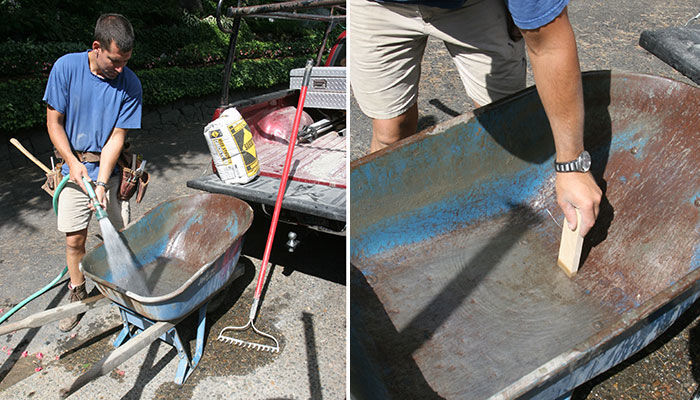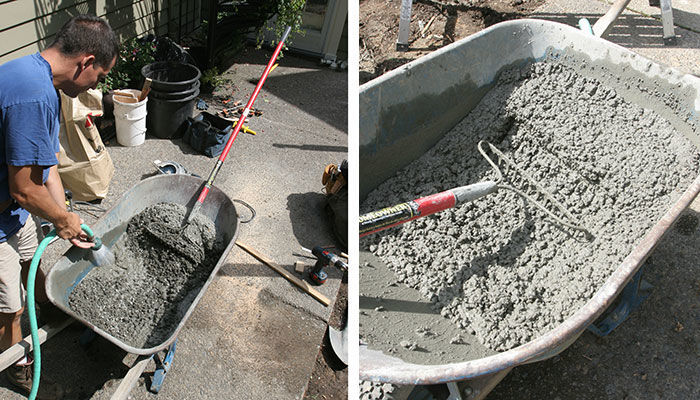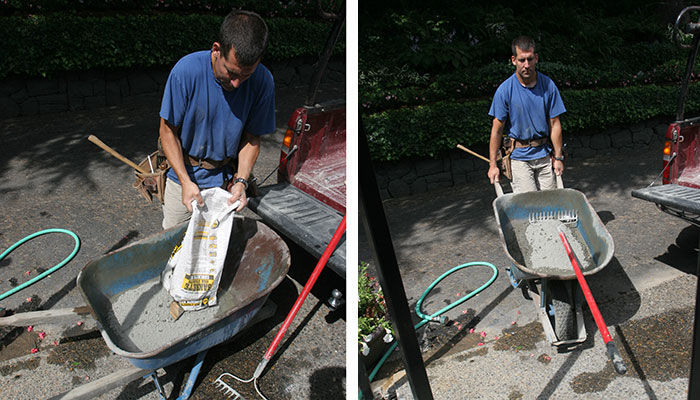Mix Concrete by the Bag
A reliable and back-friendly approach to smarter concrete-mixing.

Some people might assume that mixing concrete is an obvious task: Buy a bag of premix, dump it in a wheelbarrow with some water, and mix it up. Sounds simple, right? As a fence and deck contractor, I have learned otherwise. I often have to mix five to ten bags in an afternoon, then have to push around wheelbarrow loads of wet concrete. This chore was a strong motivator for me to come up with an efficient, reliable mixing system.
The first step to smarter concrete-mixing is to use my truck’s tailgate as a platform for emptying the concrete premix into the wheelbarrow. This setup limits the number of times I have to move the bags of concrete and keeps them at a comfortable working height. Second, I put the water in the wheelbarrow before the concrete. This step helps to keep down the dust and prevents dry pockets in the mix. Third, I use a stiff rake to mix the concrete. A rake mixes more efficiently and is easier to work with than a hoe or a shovel. Finally, to keep from straining the operator (me), I mix only one 90-lb. bag at a time. I don’t think mixing two bags at once is any faster, and I know it tires me out sooner.
After I’ve finished, I pour any excess concrete into a compact lump to be removed once it hardens. Then I wash out the wheelbarrow so that it’s ready to work another day.
Sturdy, stable, and sized right

When it comes to wheelbarrows, bigger is not always better. A medium-size 6-cu.-ft. tray is large enough to hold as much wet concrete or rock as I can move comfortably but is not so big that it’s unwieldy. I prefer a tray made of heavy-gauge steel that, unlike plastic, is not affected by UV-rays and won’t crack if the temperature dips into single digits. Nice extras on any wheelbarrow are solid hardwood handles for easy gripping and anti-tilt-back supports on the feet to reduce the chance that I’ll end up with a load of concrete exactly where I don’t want it. All this adds up to a wheelbarrow that can take the abuse of a full-time professional. For more information, visit www.jacksonprofessional.com.
Step by Step: Combine water and concrete at the truck
1. Put in the water first. For this size of wheelbarrow, add water to a depth of about 1 in. Too little water is better than too much because you always can add more later.

2. Use a piece of dry wood as a depth gauge. The water level shows clearly.
3. Add the concrete. Place the unopened bag in the water. Then use a utility knife to open the bag with a single cut along the end. Grab the bottom of the bag and tip it up so that the concrete slides out rather than pours out. This technique minimizes dust.
4. Move the mix to where it’s needed. To maneuver through tight areas without hanging up the rake, put the working end of the rake in the wheelbarrow with the handle pointing ahead.
5. Stand in front to mix. Pull the concrete to the front, and water will flow in behind it. Because I’m standing at the front of the wheelbarrow, I now can work the concrete without having the wheelbarrow move as I push back and forth. Let the water flow in after each push-and-pull stroke.

6. Keep mixing until most of the water is absorbed.
7. Add water in small amounts. Too much will weaken the concrete, so add a little water at a time, then mix. Aim for the texture of dry cottage cheese.

8. The final test. I’m done when all the concrete is wet and I’ve scraped the rake along the bottom and sides to remove any dry pockets. The mix passes my personal slump test when it’s all wet but still firm enough for the rake’s furrows to hold their shape.
—Scott Grice is a fence and deck specialist in Portland, Ore.
Photos by John Ross, except where noted.
From Fine Homebuilding #186
Magazine Extra: Watch a video demo of Scott Grice’s stress-reducing technique for mixing concrete in a wheelbarrow.






